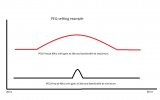Finally got my pair of FVX12. In one phrase I would say I was “blown away”. The woofers are heavy and difficult to move around, but noticing a little physics couldn’t solve ;-) . Next I hooked them via LFE and they sounded awesome. The lows in particular didn’t drop off till 15 Hz though there was a bit of port noise with the famous Edge of Tomorrow opening scene. Watching 1h30m of Transformers Last Knight, i realized this bass was tiring. Nothing to do with the subwoofer, it was the room. Hard flooring, combination of Gypsum RCC a horizontal beam in the ceiling in the middle of the room, extending 2 feet below the ceiling and glass. No audio equipment is built to deal with this and does throw harmonics off and that is to be expected in a normal room. Currently I have very minimal to no acoustic treatments in my room. First setup position of woofers. Did my calculations of standing waves and placed them at 2nd standing wave position. My room is 23x13 feet so I set the ports at the intersection of 5.75 and 3.25 feet from the front and left and right walls. Though the targeted standing waves were dealt with nicely the others got aggravated and the exercise was a failure. From Harman paper of multi sub placements I decided to exploit the corners, FL and FR for me.
Next I started measurements. Hooked up my umik1 and set it at MLP and lo behold, below 30 Hz I had a gain of about 10 dB upto 13Hz with lul at 40Hz and 60Hz. Started playing with a rough house curve I set up in my REW and applied peq filters (10 for minidsp 2x4HD)and fed them into the said device. The bass sounded lower ofcourse, mainly coz therew is good for negative gain at frequencies that need a cut and not good at adding gain at frequencies that need a push.
Straight up went to second set of measurements, this time adding boost in the MiniDSP inputs at frequencies that were lower, rinsed and repeated and the curve now saw a lot of the 40Hz and 60Hz drop removed. I boosted 10db to the input and I was a happy man. Next I eyeballed a house curve. For those of you who don’t know, a flat line is the perfect sub response with a *. That * means you’re sitting in the open with no walls glass furniture etc. with low frequency the tendency of a 30Hz volume is perceived lower than 200Hz at same decibe reading, ie human ears are less sensitive to picking up lower frequencies. My house curve from my calculations put 20Hz and 120Hz at same volume peaking at about 35Hz with an overall gain of about 7db ( I’ll revisit and give finer corrections later) from 20Hz decibel.
the result was superb.
Replaying the edge of tomorrow sounded less boomy and less tiring. The head didn’t vibrate that much here as the sofas still feel a bit wiggly with superb bass. The club scene in John Wick when he pulls out the gun and shoots through glass sent each bullet shot directly into my chest. SUPERB. Next up came Godzilla (latest one) starting scene, those 3 steps with increasing intensity and the roar is perfect check for bass headroom and I realized I had plenty.
Disclaimer, not paid by any individual or company for this post. Things mentioned in these reviews are borrowed from friends or bought by self for individual use. The woofer gain knob is still set to 12 o’clock position and because of the MiniDSP I don’t need to worry about changing levels on each sub individually and later messing it up to make it sound lopsided bass. Overall the current drop at different seating positions (2 rows) is about 4-6 dB at various frequencies but I generally don’t use more than 1 row where the drop is less than 2 dB calculated by REW and application of var filter.
peq can be used only when using line in and doesn’t work with lfe in. It is to boost or cut down on frequencies with a selectable dB and q. All peq work the same so Rythmik by Salk should be no different.


